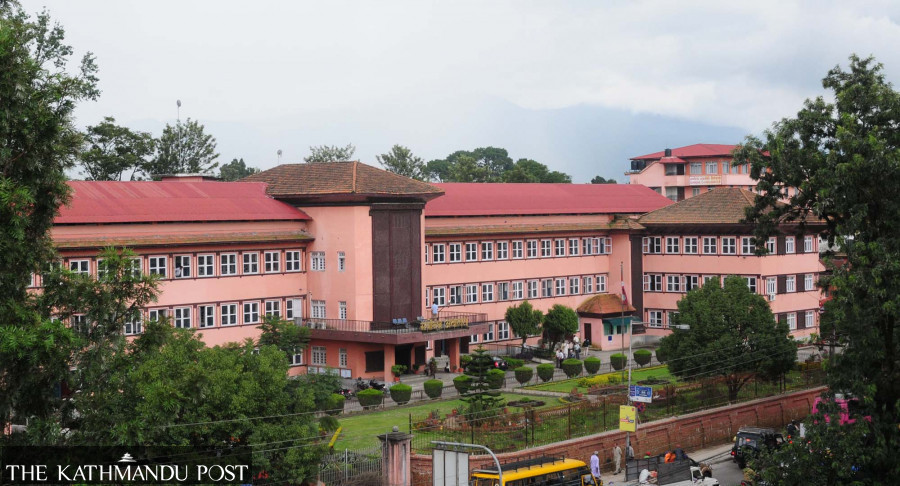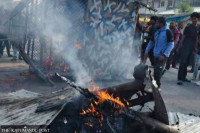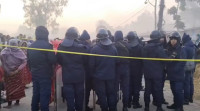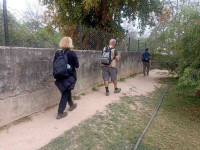National
Justices return to work after a week, set to discuss chief justice’s proposal
Congress leader Sitaula says if needed his party will intervene to resolve the dispute in the judiciary.
Tika R Pradhan
Amid mounting public pressure, the protesting Supreme Court justices resumed hearings of habeas corpus petitions on Monday.
They had been boycotting the benches since last week demanding resignation of the beleaguered chief justice, Cholendra Shumsher Rana, accusing him of irregularities. Their protest had affected many justice seekers.
Although the justices have bowed to public demands and returned to work, it remains unclear whether Chief Justice Rana will resign from his post.
The Supreme Court has altogether 20 justices, including the chief justice.
Three representatives of the justices started talks with Rana on Sunday after he hinted that he was willing to make a “graceful exit”. The details are however not known.
According to justices, they want Rana to go on leave for some time before quitting, a proposal that he has not accepted yet.
They said that they returned to work because the chief justice agreed to their request that he should stop hearing cases and assign the justices only habeas corpus petitions.
Chief Justice Rana on Monday allocated one writ petition each to six benches while he himself refrained from hearing cases, as demanded by the justices.
“We have resumed work after the chief justice agreed to our proposal. He has also agreed not to hear any cases as demanded by the Nepal Bar Association,” said one of the 16 justices present at the court on Monday.
Rana agreeing to sit out hearings could be an overture to the justices and the legal fraternity showing that he is after all willing to make a graceful exit from the Supreme Court.
But the justices are not fully convinced, since Rana’s exit plan is yet to be discussed among them.
Sources at the Supreme Court say that Rana has intimated to some colleagues that he wishes to remain in office for at least another six months and that he was ready to assign cases to justices by drawing lots, a longstanding demand of the justices.
Various studies conducted by the court including a recent one headed by Justice Hari Krishna Karki have recommended that the cause list [a list of cases to be heard by a bench on a particular day] should be prepared through an automated system and until such a system is developed, the list be prepared by drawing lots.
The measure was recommended in an attempt to control the notorious practice of bench-shopping, a term used for the unscrupulous practice of selecting benches through middlemen to ensure a favourable order.
Sources at the Supreme Court also say that Chief Justice Rana has also demanded that the justices withdraw all their accusations against him to facilitate his ‘graceful’ exit.
A member of the team of justices involved in talks with Rana told the Post that they will announce the details of the chief justice’s exit plan on Tuesday after a meeting with other justices.
“To create an environment for dialogue, we have asked the chief justice to continue assigning cases and benches just like he did today, on Tuesday as well,” the justice told the Post.
The three justices held a three-hour-long meeting with the chief justice from 5 pm to 8 pm on Monday.
“We are waiting for the three justices to brief other justices on Rana’s exit proposal,” another justice told the Post. “Our protests will continue even after we are briefed on the proposal. After that we will discuss the proposal to explore an amicable solution to the ongoing impasse.”
Hundreds of hearings at the Supreme Court remain stalled since last week after all the justices stopped work demanding the chief justice’s resignation.
The three justices—Anil Kumar Sinha, Sapana Pradhan Malla and Manoj Kumar Sharma—had also held a meeting with the chief justice on Sunday and briefed the other justices on the developments on Monday.
At the meeting of the justices on Monday, 16 justices were present since three justices including Ishwar Khatiwada, Tej Bahadur KC and Nahakul Subedi are on leave.
Meanwhile, the Nepal Bar Association continued their sit-in at the association’s office in Kathmandu for the second straight day. Lawyers affiliated to the association, the umbrella organisation of lawyers across the country, staged an hour-long sit-in from 10:30 am to 11:30 am on Monday.
“Nepal Bar cannot backtrack on its decision now. Nor can we accept him [Cholendra Shumsher Rana] as chief justice anymore,” said Shambhu Thapa, a senior advocate.
Thapa said Rana should not hold the judiciary hostage for long as the justices themselves and lawyers have demanded his resignation.
On Monday, Rana had assigned habeas corpus petitions to four division benches of Bishwambhar Prasad Shrestha and Hari Prasad Phuyal; Ananda Mohan Bhattarai and Tanka Bahadur Moktan; Anil Kumar Sinha and Kumar Chudal; Sapana Pradhan Malla and Manoj Kumar Sharma; and two single benches of Bam Kumar Shrestha and Kumar Regmi.
According to senior advocates, the chief justice has been trying to convince the justices for a compromise after knowing that he has no option left. But Nepal Bar Association Chairman Chandeshwar Shrestha maintains that Rana’s resignation alone will not be enough to cleanse the judiciary of all the ills.
“As a chief justice, he has failed miserably,” said senior advocate Badri Bahadur Karki, who is also an expert on constitutional law. “My only advice to him [Rana] is: don’t convert your personal failures into the institution’s failure.”
Meanwhile, as the political parties have become mere spectators to the ongoing agitation, some politicians have called for political intervention to resolve the crisis.
On Monday, speaking at a function in Kathmandu, Nepali Congress senior leader Krishna Prasad Sitaula said if needed his party would intervene in the dispute saying a prolonged dispute could threaten the democratic system. “Ours is the party that can resolve all the problems of the country. And if needed we will take initiatives to resolve the dispute,” Sitaula said at a tea party organised by his party unit at Tarakeshwar Municipality.
Protesting lawyers have meanwhile said they will resort to stringent forms of protest if the chief justice continues “to hold the judiciary hostage.”
“Today we were told not to cross the prohibited area [the Supreme Court]. Tomorrow we will break into the prohibited area and the day after tomorrow things will be different,” said senior advocate Prem Bahadur Khadka, who is also a former chair of the Nepal Bar Association. “Rana has failed the judiciary. He cannot withstand our protest.”
Senior advocate Satish Krishna Kharel said the parties will have to pay the cost of not speaking when the judiciary is in crisis.




 12.12°C Kathmandu
12.12°C Kathmandu













%20(1).jpg&w=300&height=200)

